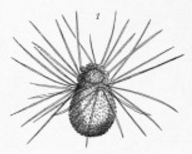Rhizaria
Rhizaria is a super-group of mostly unicellular eukaryotes, a diverse group that includes organisms such as radiolaria, foraminifera, and various amoeboid protists. This super-group is characterized by its members' unique form of locomotion, which involves pseudopodia – extensions of the cell body that can help in movement and feeding. Rhizaria is recognized as one of the major groups within the Eukaryota domain, playing a significant role in ecological processes, especially in oceanic environments.
Classification[edit | edit source]
Rhizaria belongs to the domain Eukaryota, which encompasses all life forms with complex cells containing a nucleus. Within Eukaryota, Rhizaria is considered a super-group, indicating its members share common genetic and morphological characteristics that distinguish them from other eukaryotic groups. The classification of Rhizaria has evolved over time with advances in molecular biology and genomics, leading to a more refined understanding of its phylogenetic relationships.
Subgroups[edit | edit source]
Rhizaria is divided into several major subgroups, including:
- Cercozoa: A diverse group that includes both photosynthetic and heterotrophic organisms, many of which are amoeboid with filose pseudopodia.
- Foraminifera: Characterized by their intricate calcium carbonate shells, foraminifera are primarily marine organisms that play a crucial role in sediment formation and the carbon cycle.
- Radiolaria: Known for their intricate silica-based skeletons, radiolaria are important components of marine plankton, contributing to the ocean's silica cycle.
Ecology and Importance[edit | edit source]
Rhizaria members are predominantly found in marine environments, where they contribute significantly to biogeochemical cycles. Foraminifera and radiolaria, for example, are key players in the carbon and silica cycles, respectively. These organisms also serve as important indicators of environmental conditions and changes over geological timescales, making them valuable in the field of paleoclimatology.
Research and Challenges[edit | edit source]
Studying Rhizaria poses several challenges, primarily due to their microscopic size and the complexity of their life cycles. Advances in molecular and genomic techniques have significantly improved our understanding of Rhizaria's diversity and evolutionary history. However, much remains to be discovered about their ecological roles and interactions with other marine organisms.
Conclusion[edit | edit source]
Rhizaria is a vital component of the eukaryotic domain, with its members playing crucial roles in ecological and biogeochemical processes. Despite the challenges in studying these organisms, ongoing research continues to unveil the complexity and significance of this diverse group.
Transform your life with W8MD's budget GLP1 injections from $125
W8MD offers a medical weight loss program NYC and a clinic to lose weight in Philadelphia. Our W8MD's physician supervised medical weight loss centers in NYC provides expert medical guidance, and offers telemedicine options for convenience.
Why choose W8MD?
- Comprehensive care with FDA-approved weight loss medications including:
- loss injections in NYC both generic and brand names:
- weight loss medications including Phentermine, Qsymia, Diethylpropion etc.
- Accept most insurances for visits or discounted self pay cost.
- Generic weight loss injections starting from just $125.00 for the starting dose
- In person weight loss NYC and telemedicine medical weight loss options in New York city available
- Budget GLP1 weight loss injections in NYC starting from $125.00 biweekly with insurance!
Book Your Appointment
Start your NYC weight loss journey today at our NYC medical weight loss, and Philadelphia medical weight loss Call (718)946-5500 for NY and 215 676 2334 for PA
Search WikiMD
Ad.Tired of being Overweight? Try W8MD's NYC physician weight loss.
Semaglutide (Ozempic / Wegovy and Tirzepatide (Mounjaro / Zepbound) available. Call 718 946 5500.
Advertise on WikiMD
|
WikiMD's Wellness Encyclopedia |
| Let Food Be Thy Medicine Medicine Thy Food - Hippocrates |
Translate this page: - East Asian
中文,
日本,
한국어,
South Asian
हिन्दी,
தமிழ்,
తెలుగు,
Urdu,
ಕನ್ನಡ,
Southeast Asian
Indonesian,
Vietnamese,
Thai,
မြန်မာဘာသာ,
বাংলা
European
español,
Deutsch,
français,
Greek,
português do Brasil,
polski,
română,
русский,
Nederlands,
norsk,
svenska,
suomi,
Italian
Middle Eastern & African
عربى,
Turkish,
Persian,
Hebrew,
Afrikaans,
isiZulu,
Kiswahili,
Other
Bulgarian,
Hungarian,
Czech,
Swedish,
മലയാളം,
मराठी,
ਪੰਜਾਬੀ,
ગુજરાતી,
Portuguese,
Ukrainian
Medical Disclaimer: WikiMD is not a substitute for professional medical advice. The information on WikiMD is provided as an information resource only, may be incorrect, outdated or misleading, and is not to be used or relied on for any diagnostic or treatment purposes. Please consult your health care provider before making any healthcare decisions or for guidance about a specific medical condition. WikiMD expressly disclaims responsibility, and shall have no liability, for any damages, loss, injury, or liability whatsoever suffered as a result of your reliance on the information contained in this site. By visiting this site you agree to the foregoing terms and conditions, which may from time to time be changed or supplemented by WikiMD. If you do not agree to the foregoing terms and conditions, you should not enter or use this site. See full disclaimer.
Credits:Most images are courtesy of Wikimedia commons, and templates, categories Wikipedia, licensed under CC BY SA or similar.
Contributors: Prab R. Tumpati, MD







